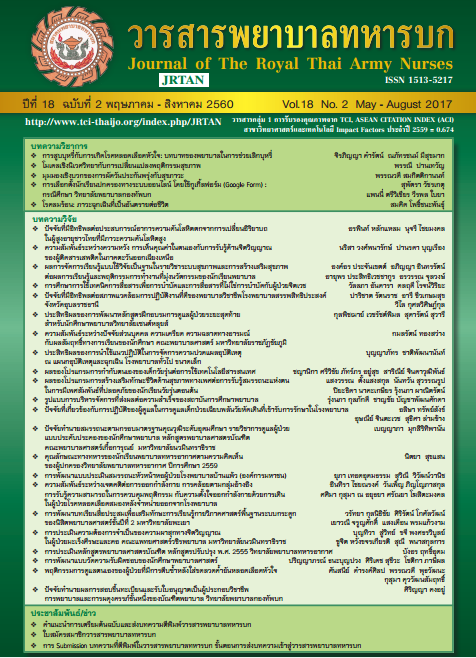ความสัมพันธ์ระหว่างเจตคติต่อการออกกำลังกาย การคล้อยตามกลุ่มอ้างอิง การรับรู้ความสามารถในการควบคุมพฤติกรรม กับความตั้งใจออกกำลังกายด้วยการเดิน ในผู้ป่วยโรคหลอดเลือดสมองหลังจำหน่ายออกจากโรงพยาบาล
Keywords:
โรคหลอดเลือดสมอง, เจตคติต่อการออกกำลังกาย, การคล้อยตามกลุ่มอ้างอิง, การรับรู้ความสามารถในการควบคุม พฤติกรรม, ความตั้งใจออกกำลังกายด้วยการเดิน, Stroke patients, Attitude toward exercise, Subjective norms, Perceived behavioral control, Walking exercise inteAbstract
การวิจัยนี้มีวัตถุประสงค์เพื่อศึกษาความสัมพันธ์ระหว่างเจตคติต่อการออกกำลังกายการคล้อยตามกลุ่มอ้างอิงและการ รับรู้ความสามารถในการควบคุมพฤติกรรมกับความตั้งใจออกกำลังกายด้วยการเดินในผู้ป่วยโรคหลอดเลือดสมองกลุ่มตัวอย่างเป็น ผู้ป่วยโรคหลอดเลือดสมองขาดเลือดที่ได้รับการวินิจฉัยครั้งแรกจำนวน 78ราย ที่มารับบริการหน่วยผู้ป่วยนอกโรงพยาบาลภูมิพล อดุลยเดชและโรงพยาบาลธรรมศาสตร์เฉลิมพระเกียรติเก็บข้อมูลโดยใช้แบบบันทึกข้อมูลส่วนบุคคลแบบสอบถามเจตคติต่อการ ออกกำลังกาย การคล้อยตามกลุ่มอ้างอิง การรับรู้ความสามารถในการควบคุมพฤติกรรม และความตั้งใจในการออกกำลังกายด้วย การเดิน วิเคราะห์ข้อมูลด้วยสถิติบรรยาย และสถิติสหสัมพันธ์ของเพียร์สัน ผลการวิจัยพบว่า กลุ่มตัวอย่างมีความตั้งใจออกกำลังกายด้วยการเดินระดับมากที่สุด ร้อยละ 73.1 เมื่อวิเคราะห์ ความสัมพันธ์พบว่า เจตคติต่อการออกกำลังกาย การคล้อยตามกลุ่มอ้างอิง และการรับรู้ความสามารถในการควบคุมพฤติกรรม มีความสัมพันธ์ทางบวกกับความตั้งใจออกกำลังกายด้วยการเดิน อย่างมีนัยสำคัญทางสถิติ(r = .409, p < .01, r = .309, p < .01, และ r = .293, p < .01 ตามลำดับ) จากผลการวิจัยนี้ พยาบาลควรให้ความรู้และสร้างความตระหนักถึงความสำคัญของการออกกำลังกายด้วยการเดิน แก่ผู้ป่วยตั้งแต่เข้ารับการรักษาในโรงพยาบาล เพื่อส่งเสริมให้ผู้ป่วยเกิดความตั้งใจฟื้นฟูอย่างต่อเนื่อง
The Relationships among Attitude Toward Exercise, Subjective Norms, Perceived Behavioral Control and Walking Exercise Intention in Post Stroke Patients after Hospital Discharge
The purposeof this study was toexplore the relationship among attitude toward exercise, subjective norms, and perceived behavioral control, and walking exercise intention in post stroke patients after hospital discharge. The samples consisted of 78 first-ever ischemic stroke patients who attended at the outpatient clinics at Bhumipol Adulyadej Hospital and Thammasat University Hospital. The data were collected by using a demographic questionnaire, attitude toward exercise, subjective norms, perceived behavioral control, and walking exercise intention. Data were analyzed by using descriptive statistics and Pearson’s product moment correlation. The findings revealed that 73.1 % of the samples had the highest walking exercise intention.Attitude toward exercise, subjectivenorms and perceived behavioral controlhad positiverelationships withthe walking exercise intention in post stroke patients after hospital discharge with statistical significance (r = .409, p < .01, r = .309, p < .01, and r = .293, p < .01 respectively). Based on the findings, nurses should provide education and raise awareness about the importance of walking exercise for stroke patients starting at admission to the hospital to promote walking exercise intention for rehabilitation continuously.
Downloads
Downloads
How to Cite
Issue
Section
License
บทความหรือข้อคิดเห็นใดใดที่ปรากฏในวารสารพยาบาลทหารบกเป็นวรรณกรรมของผู้เขียน ซึ่งบรรณาธิการหรือสมาคมพยาบาลทหารบก ไม่จำเป็นต้องเห็นด้วย
บทความที่ได้รับการตีพิมพ์เป็นลิขสิทธิ์ของวารสารพยาบาลทหารบก
The ideas and opinions expressed in the Journal of The Royal Thai Army Nurses are those of the authors and not necessarily those
of the editor or Royal Thai Army Nurses Association.






